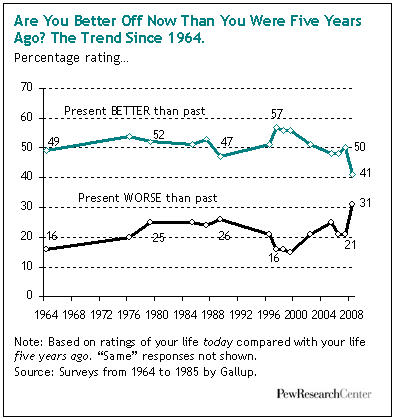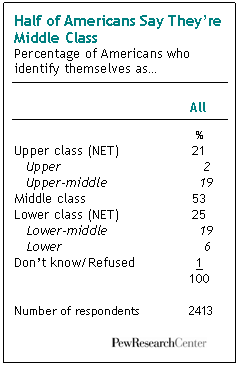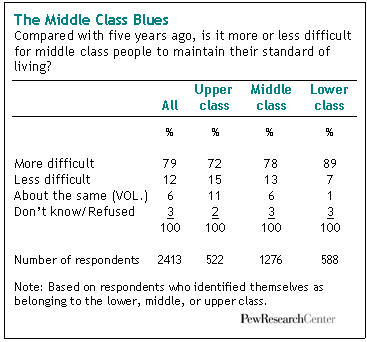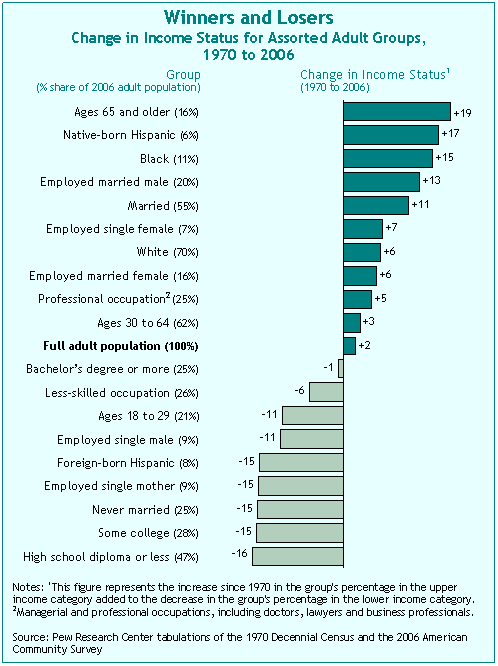I. Executive Summary
This report on the attitudes and lives of the American middle class combines results of a new Pew Research Center national public opinion survey with the center’s analysis of relevant economic and demographic trend data from the Census Bureau. Among its key findings:
Fewer Americans now than at any time in the past half century believe they’re moving forward in life.
-

Americans feel stuck in their tracks. A majority of survey respondents say that in the past five years, they either haven’t moved forward in life (25%) or have fallen backward (31%). This is the most downbeat short-term assessment of personal progress in nearly half a century of polling by the Pew Research Center and the Gallup organization.
- When asked to measure their progress over a longer time frame, Americans are more upbeat. Nearly two-thirds say they have a higher standard of living than their parents had when their parents were their age.
For decades, middle income Americans had been making absolute progress while enduring relative decline. But since 1999, they have not made economic progress.
- As of 2006 (the last year for which trend data are available), real median annual household income had not yet returned to its 1999 peak, making this decade one of the longest downturns ever for this widely-accepted measure of the middle-class standard of living. Over a longer time period, the picture is much brighter; since 1970, median household income has risen by 41%.
- However, this long-term prosperity has not spread evenly. The upper income tier (households with annual incomes above 150% of the median) has outperformed the middle tier (households with annual incomes between 75% and 150% of the median) — not just in income gains, but also in wealth accumulation. From 1983 to 2004, the median net worth of upper income families grew by 123%, while the median net worth of middle income families grew by just 29%. In effect, those in the middle have been making progress in absolute terms while falling behind in relative terms.

About half of all Americans think of themselves as middle class. They are a varied lot.
- Some 53% of adults in America say they are middle class. On key measures of well-being — income, wealth, health, optimism about the future — they tend to fall between those who identify with classes above and below them. But within this self-defined middle class, there are notable economic and demographic differences. For example, four-in-ten Americans with incomes below $20,000 say they are middle class, as do a third of those with incomes above $150,000. And about the same percentages of blacks (50%), Hispanics (54%) and whites (53%) self-identify as middle class, even though members of minority groups who say they are middle class have far less income and wealth than do whites who say they are middle class.
For the past two decades middle income Americans have been spending more and borrowing more. Housing has been the key driver of both trends.
- A new single family house is about 50% larger and existing houses are nearly 60% more expensive (in inflation adjusted dollars) now than in the mid 1980s. Goods and services that didn’t exist a few decades ago– such as high definition television, high speed internet, and cable or satellite subscriptions– have become commonplace consumer items. And the costs of many of the anchors of a middle class lifestyle– not just housing, but medical care and college education– have risen more sharply than inflation.
- As expenses have risen, middle income Americans have taken on more debt, often borrowing against homes that, at least until recently, had been rising rapidly in value. The median debt-to-income ratio for middle income adults increased from 0.45 in 1983 to 1.19 in 2004. Ratios have also increased for upper and lower income adults, but not by as much.
At a time when these borrow-and-spend habits have spread, Americans say it has become harder to sustain a middle class lifestyle.
-

Nearly eight-in-ten (79%) respondents in the Pew Research Center survey say it is more difficult now than five years ago for people in the middle class to maintain their standard of living. Back in 1986, just 65% of the public felt this way.
- The current economic slowdown and uptick in prices are taking a bite out of the family budget. Slightly more than half of middle class respondents say they’ve had to tighten their belts in the past year. Roughly the same proportion expect to make more cutbacks in the year ahead, and a quarter say they expect to have trouble paying their bills. About a quarter of those who are employed worry they could lose their job.
- Nonetheless, the American middle class is optimistic about the future. Most are confident that their quality of life in five years will be better than it is now. And, gazing farther ahead, most expect their children to do better in life than they themselves have done.
Economic, demographic, technological and sociological changes since 1970 have moved some groups up the income ladder and pushed others down.
- Winners include seniors (ages 65 and older), blacks, native-born Hispanics and married adults. The income status of all of these groups improved from 1970 to 2006. Losers include young adults (ages 18 to 29), the never-married, foreign-born Hispanics and people with a high school diploma or less. All of these groups have seen their relative income positions decline.

Most middle class adults agree with the old saw that the Republican Party favors the rich while the Democratic Party favors the middle class and the poor.
- Nearly six-in-ten (58%) middle class survey respondents say the Republican Party favors the rich, while nearly two-thirds say the Democratic Party favors the middle class (39%) or the poor (26%).




